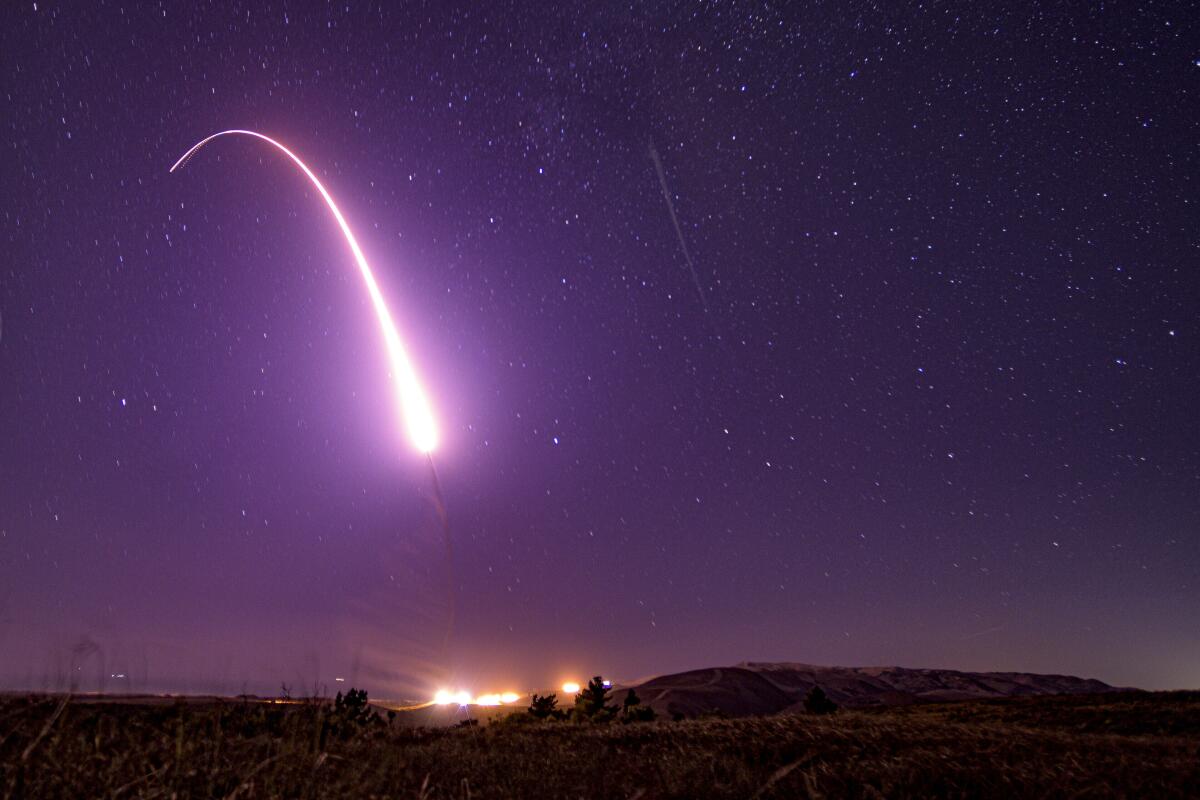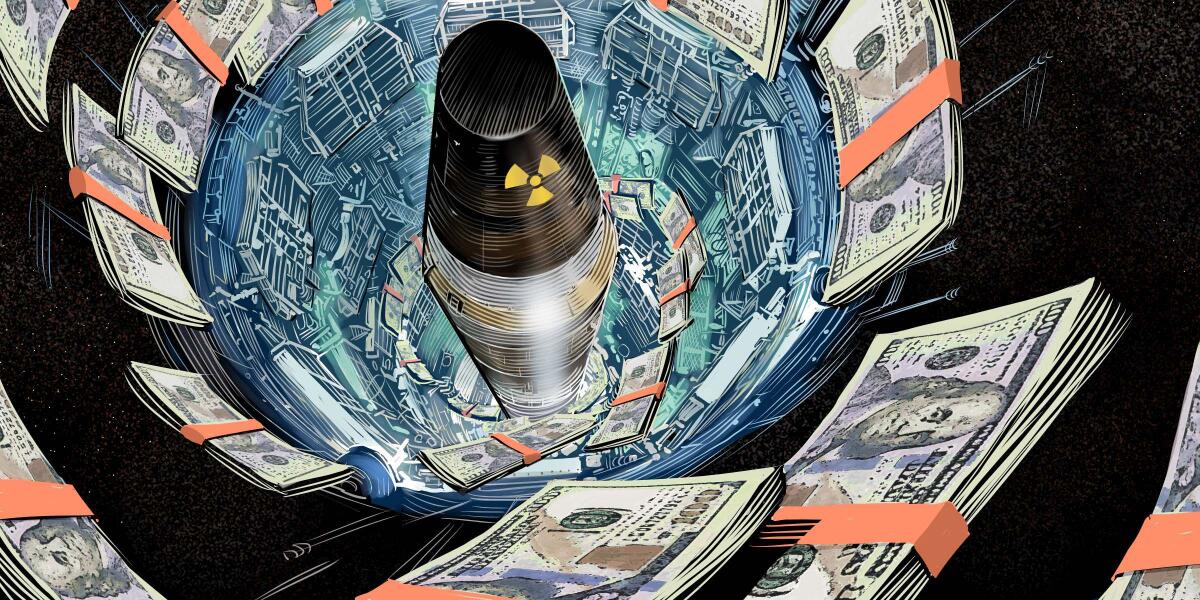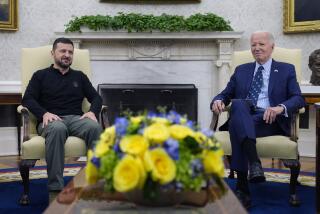Under Trump, America’s nuclear weapons industry has boomed

While the country has been preoccupied with the COVID-19 pandemic, economic decline and the election, President Trump’s administration quietly and steadily steered America’s nuclear weapons industry to its largest expansion since the end of the Cold War, increasing spending on such arms by billions of dollars with bipartisan congressional support.
Overall, the budget for making and maintaining nuclear warheads has risen more than 50% since Trump was elected in 2016, substantially outpacing the rates of increase for the defense budget and overall federal spending during his presidency before the pandemic. On Monday, Congress approved Trump’s proposal to increase spending next year for the production of such weaponry by nearly $3 billion.
President-elect Joe Biden may embrace other priorities as he confronts the pandemic, tries to steer the country out of a recession, and is pressured to address social programs neglected under the Trump administration, as well as a ballooning deficit created by the 2017 Trump tax cuts and COVID-19 stimulus spending.
But the creation of a larger and more modern nuclear warhead complex of factories, laboratories and related businesses is already playing out around the country, despite slowdowns in other federal projects due to the pandemic.
Four factories in Texas, South Carolina, Tennessee and New Mexico dedicated to producing warheads are being modernized. Four existing warheads are being substantially rebuilt with modern parts, on top of another such upgrade ‚ÄĒ costing $3.5 billion ‚ÄĒ that was completed last year. This pace compares with an average modernization of one type of warhead at a time during the Obama administration.
‚ÄúOver the next five years, the [nuclear weapons-related] costs start going up dramatically,‚ÄĚ Mackenzie Eaglen, a former congressional staff member who is now a resident fellow at the American Enterprise Institute, said at a recent defense conference. ‚ÄúThese are sharp, significant increases, and we are not seeing sharp, significant increases in defense spending overall.‚ÄĚ

Jon Wolfsthal, a White House advisor on nuclear weapons issues while Biden was serving as vice president, said in an interview that the new Democratic administration may adopt different policies.
‚ÄúI think Biden will look at the full suite of these issues. It is well known to him and his advisors that the cost of nuclear modernization is very high and that that money can be better invested elsewhere. But how he decides to allocate those resources and when he decides to take on those bureaucratic fights is something they still themselves don‚Äôt know,‚ÄĚ Wolfsthal told a Nov. 18 symposium organized by the Ploughshares Fund, a group that promotes nuclear nonproliferation.
The roots of a fifth warhead program
One of the most vulnerable Trump nuclear programs in the Biden era might be a plan to start work on a new warhead, a program that fulfills a controversial, long-held ambition by the three major government-owned, privately run nuclear weapons laboratories.
Since the U.S. halted its nuclear explosive testing in 1992, many weapons engineers at the nation‚Äôs key laboratories in Los Alamos, N.M., and Livermore, Calif., have chafed at policy restrictions on the creation of warheads with novel designs ‚ÄĒ a limitation that crimps their business income and, in their view, undermines the scientific excitement underlying their work.
Advisors to President Obama spurned such appeals, arguing that making warheads with novel designs would alarm other nations and cause them to do likewise. ‚ÄúWe see no need for additional nuclear weapons of a new type, either in capability or in capacity,‚ÄĚ Gen. James Cartwright, then-vice chairman of the Joint Chiefs of Staff, said in 2010.
But the labs helped turn this view around during Trump‚Äôs tenure. Their directors in March 2017 then jointly sent a confidential, 17-chapter, summary paper to Trump‚Äôs initial secretaries of Energy and Defense, which pointedly posed the following question: Should ‚Äúcurrent policy constraining the fielding of new warheads, or warheads with new or different military capabilities, be continued?‚ÄĚ
Lifting that restriction, the lab directors said, would ‚Äúprovide weapons designers with unique opportunities to exercise, and thereby sustain, certain critical skills,‚ÄĚ according to an excerpt of the heavily redacted copy of the paper the Center for Public Integrity obtained in a Freedom of Information Act request.
This year, their wish came at least partly true. The Trump administration asked Congress for $53 million to begin designing a warhead new enough to get its own title, the W93. Officials say that while some of its explosive parts will be based on existing weapons designs, it is a replacement, not a refurbishment, for older warheads now deployed atop submarine-launched missiles ‚ÄĒ including one that completed a modernization program last year.
The funds approved for the W93 this year are less than 1% of its projected $10-billion to $14-billion cost, but amount to a politically significant green light and a reversal of Obama‚Äôs policy to avoid creating new warheads. A year ago, the program ‚ÄĒ which has the support of Britain because it will share in the warhead‚Äôs deployment ‚ÄĒ was not set to begin until 2023, so Trump appointees hurried it up.
Nuclear manufacturing ramps up
Besides the ramp-up in warhead production, hundreds of new strategic missiles and bombers and a dozen advanced submarines ‚ÄĒ all designed to carry nuclear weapons to targets in Russia, China, North Korea or Iran ‚ÄĒ are under intensifying development. The Air Force signed a contract on Sept. 8 to begin spending at least $93 billion on new, land-based, nuclear-tipped missiles, for example, and the Navy has been accelerating its spending for new missile-carrying submarines that will cost a total of $128 billion. The projected spending on all these systems has been estimated by congressional experts at roughly $50 billion a year over the next decade alone.
A nuclear warhead ordered into production by Trump and his advisors ‚ÄĒ a 3-foot-tall, cone-shaped weapon with roughly half the explosive force of the bomb that destroyed Hiroshima ‚ÄĒ was built last year and has begun to be deployed. The administration also reversed an Obama-era decision to retire the largest nuclear weapon in the U.S. arsenal, the B83, keeping roughly 100 warheads, each with 80 times the power of the bomb that destroyed Hiroshima, in active status.
The administration further agreed to spend $1 billion upgrading an underground site in Nevada where government scientists test weapons designs in explosions that fall just short of a so-called nuclear chain reaction, so it can increase the number of such tests and collect more data in each one. And it has also begun construction of a new, $144-million bunker for storing nuclear weapons in Cheyenne, Wyo., as big as 18 basketball courts.
Roughly 50,000 Americans are now involved in making nuclear warheads at eight principal sites stretching from California to South Carolina. And the three principal U.S. nuclear weapons laboratories ‚ÄĒ located in Los Alamos and Albuquerque, N.M., and Livermore, Calif. ‚ÄĒ have said they are adding thousands of new workers at a time when the overall federal workforce is shrinking.
Those in Los Alamos are preparing to make the first new explosive cores for deployed nuclear weapons produced in the last five years, a costly and difficult task that will expand in a few years from one site to two. The National Nuclear Security Administration, or NNSA, which oversees the work, held hiring fairs in half a dozen cities and college campuses and accelerated training and apprenticeship, so that the job of building weapons can be sped up.
The nuclear security enterprise ‚Äúis busier than it has been since the end of the Cold War,‚ÄĚ Lisa Gordon-Hagerty, Trump‚Äôs appointee as the NNSA administrator until November, affirmed in Sept. 17 testimony to the Senate Armed Services Committee. Trump‚Äôs top arms control advisor, former Pentagon official Marshall Billingslea, after completing a tour of nuclear weapons sites tweeted awkwardly on Sept. 10 that the Texas facility where each of America‚Äôs nuclear warheads is assembled is ‚Äúbooming.‚ÄĚ
Pantex, he boasted, is now the ‚Äúbusiest it‚Äôs been in two decades.‚ÄĚ
Building nuclear weapons to last a century
Two of the most important additions to the nuclear weapons complex are advancing at secure sites east of Knoxville, Tenn., and in the sand hills northeast of Augusta, Ga., with the labor of thousands of workers. One is an immense $6.5-billion bunkhouse where uranium is cast into explosive shapes for hydrogen warheads, and the second is a $4.8-billion factory where dozens of plutonium cores for those warheads will eventually be produced.
The former, nearly as big as a Manhattan city block, was begun during the Obama administration and is slated for completion in 2025; it’s been rising steadily beneath what the company overseeing the work says are the two tallest free-standing construction cranes in the Western Hemisphere. The latter, already a thick-walled concrete shell as big as five city blocks, is slated to begin machining the cores later this decade. In the meantime, another factory at Los Alamos will begin churning out new cores for weapons in 2023 at a cost exceeding $3 billion.
A driving force behind the NNSA‚Äôs expansion has been a years-long effort by the nuclear weapons laboratories to modernize five of the warheads they created over the last four decades. So far, they‚Äôve largely finished one ‚ÄĒ for deployment atop submarine-launched missiles, leaving four more ‚ÄĒ for bombers, submarines and land-based missiles ‚ÄĒ still to go. Each involves more than a thousand workers at half a dozen of the NNSA‚Äôs main sites; Los Alamos alone has forecast it will need to hire 2,000 employees and spend more than $13 billion to accommodate the military‚Äôs nuclear needs over the next decade.
Congressional dissent
Ben Rhodes, a former national security aide to Obama, said at the Ploughshares symposium that ‚Äúthe insane idea that after a pandemic and dealing with climate change and in an economic crisis in which people are struggling with massive inequality that we are going to spend this much money modernizing every last piece of our nuclear infrastructure ‚ÄĒ that would be a failure, a failure of policy and a failure of imagination.‚ÄĚ
But major defense contractors and their employees ‚ÄĒ including many of those making nuclear weapons or running the national laboratories where they are designed ‚ÄĒ have long influenced budget choices by helping to finance elections of the members of Congress who approve spending for that work. The industry‚Äôs donations in the current election cycle to members of the House and Senate Armed Services committees alone had reached $9.4 million as of mid-October; of that amount, the two chairmen took in a total of at least $802,000, according to the Center for Responsive Politics, a nonpartisan research group. These tallies don‚Äôt include separate donations by lawyers or lobbyists.
In the final year of Trump’s term, there wasn’t much dissent among those committees about the nuclear programs. A May letter to the House committee chairman, Rep. Adam Smith (D-Wash.), and the top Republican, Mac Thornberry (R-Texas), urging lower defense spending in the next fiscal year so more funds could be spent combating the pandemic drew signatures from only 30 House members.
Smith said this fall that he would not contest the Trump administration‚Äôs spending plans but told the Ploughshares symposium he now believes that the size of the nuclear arsenal poses a ‚Äúthreat‚ÄĚ and that the country could have ‚Äúa lot fewer nuclear weapons.‚ÄĚ He added that while he supports reexamining the costly decision to modernize the nuclear-tipped land-based missile force, ‚ÄúI‚Äôm not optimistic‚ÄĚ the program will be halted.
More serious dissent took root in the House Appropriations Committee. Rep. Marcy Kaptur (D-Ohio), who became chair in 2019 of the subcommittee that funds nuclear weapons work, said in the spring that the administration‚Äôs plans were ‚Äúnot realistic nor executable.‚ÄĚ
The NNSA, she said, ‚Äúis trying to do far too much, too quickly,‚ÄĚ making it prone to repeat its many, past ‚Äúcostly mistakes.‚ÄĚ In a July committee vote, Kaptur persuaded her House colleagues to slice $2 billion from the administration‚Äôs proposed increase in its overall military spending bill.
But her move evoked strong protests from then-Defense Secretary Mark Esper, who said in a September letter to Congress that it will create ‚Äúunacceptable risks‚ÄĚ to America‚Äôs nuclear deterrent. In the massive budget bill approved Monday, which included nearly a trillion dollars for pandemic relief, the nuclear weapons production establishment again came out a winner, as Congress rejected Kaptur‚Äôs view and provided the NNSA with an extra $2.8 billion sought by Trump.
This story is published in partnership with the Center for Public Integrity, a Washington-based nonprofit, nonpartisan newsroom that investigates democracy, power and privilege. Smith is national security editor at the center.
More to Read
Sign up for Essential California
The most important California stories and recommendations in your inbox every morning.
You may occasionally receive promotional content from the Los Angeles Times.










